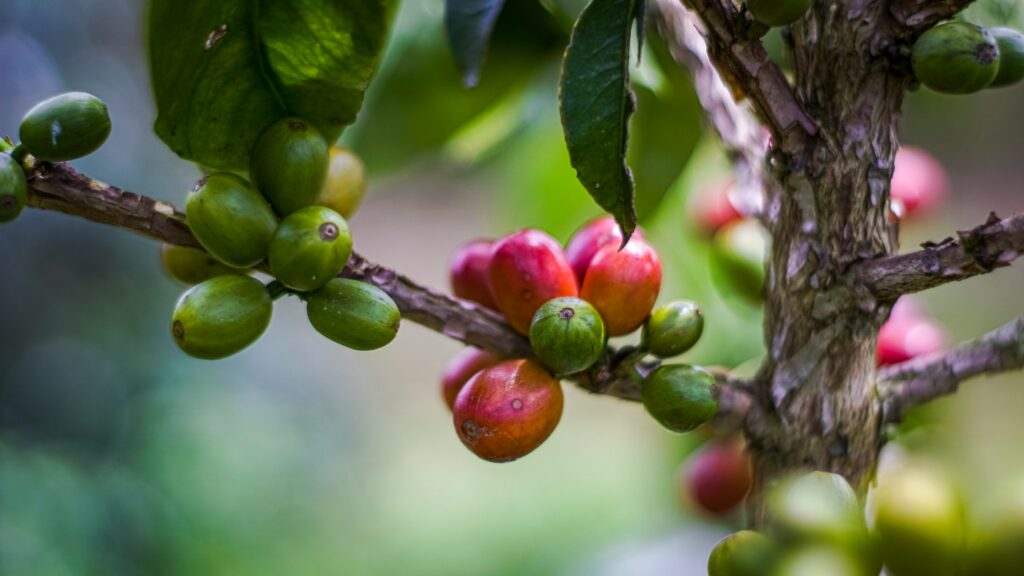Ever wonder why one cup of coffee tastes like berries and another like chocolate? It’s not magic, but it’s altitude.
Where your coffee is grown plays a huge role in how it tastes. High up in the mountains? You’ll likely get bright, fruity notes. Down low? Think smooth, mellow flavors.
Altitude changes everything—from how fast the beans grow to how complex the flavors become.
So let’s take a quick journey from misty mountain farms to your favorite mug and see how elevation shapes every sip.
What Does “Altitude” Mean in Coffee Farming?
In coffee farming, altitude refers to how high the coffee is grown above sea level which is usually measured in meters or feet. And yes, it matters a lot more than you might think.
The elevation of a coffee farm directly affects the plant’s growth, bean development, and most importantly, flavor.
Generally, coffee grown at low altitudes (below 900 meters or 2,950 feet) tends to ripen quickly due to warmer temperatures.
This often produces beans with a softer, simpler flavor—think nutty, earthy, or mild chocolate notes.
Move up the mountain to medium altitudes (between 900 and 1,200 meters), and things start to balance out: the beans develop a richer body with more noticeable acidity and sweeter undertones like caramel or soft fruit.
Now climb even higher—high-altitude farms (1,200 to over 2,000 meters or 3,940+ feet)—and you’re in specialty coffee territory.
The cooler climate at these heights slows down bean growth, which allows more complex sugars and acids to develop.
That’s how you get those bright, fruity, floral, or wine-like flavors in your cup.
The Science Behind Altitude and Coffee Growth
As altitude climbs, temperature drops, and that simple shift has a big impact on how coffee grows.
Cooler temps at higher elevations slow down the ripening process, giving the coffee cherries more time to develop.
It’s like letting fruit ripen on the vine instead of rushing it to market because slower growth means deeper, more developed flavors.
This extended maturation also creates denser beans, which is a good thing.
Dense beans pack more sugars and acids, leading to those complex flavor notes coffee lovers chase—think citrus, florals, or even hints of wine.
But there’s more: higher altitudes naturally fend off pests and diseases.
The cooler, thinner air makes it harder for bugs and fungi to thrive, reducing the need for chemicals and resulting in cleaner, healthier crops.
So while farming on a mountain is no walk in the park, the reward is a bean that’s stronger, sweeter, and full of character. In the world of coffee, slow and steady really does win the race.
Flavor Profiles by Altitude
Let’s talk taste. Altitude doesn’t just affect how coffee grows but it completely reshapes the flavor in your cup.
The higher the farm, the more time the coffee cherry has to mature, and that time works wonders for taste.
Here’s how the elevation breakdown plays out, one sip at a time:
A. Low Altitude (<900m / <2,950 ft)
At lower elevations, coffee beans grow fast due to warm temperatures. But that speed comes at a cost because flavor development is cut short.
These beans usually have a softer body, low acidity, and a mellow profile. You’ll notice earthy, nutty, or chocolaty tones that are smooth but not complex.
Great for those who like their coffee comforting and easygoing without the fruity surprises.
B. Mid Altitude (900–1,200m / 2,950–3,940 ft)
This is the “just right” zone for many coffee regions. With more moderate temperatures, beans mature at a steadier pace. The result? A pleasant balance of acidity and sweetness.
Coffees from this range tend to have medium body, gentle fruitiness, and cozy flavor notes like caramel, cocoa, and stone fruits. It’s like a warm hug in a mug—flavorful without being too bold.
C. High Altitude (1,200–2,000+m / 3,940+ ft)
Now we’re in the flavor stratosphere. At this height, coffee cherries take their sweet time to ripen, which leads to concentrated sugars and bright acidity.
These beans are denser, harder, and packed with character. Expect floral aromas, juicy fruit notes (think berry or citrus), and even wine-like complexity.
It’s no wonder specialty coffee shops love high-altitude beans because they’re the drama queens of the coffee world, and we’re here for it.
Famous Coffee-Growing Regions by Altitude
Altitude doesn’t just influence flavor but it helps define a region’s coffee identity.
Certain countries have become iconic in the coffee world not just for their beans, but for the elevations at which they grow.
These altitudes shape the flavor, the aroma, and even the texture of your brew. Let’s take a quick trip around the globe and explore how height gives each of these regions their signature taste.
Ethiopia (1,500–2,200m)
Welcome to the birthplace of coffee. Ethiopia’s high elevations produce some of the most complex and distinctive beans on Earth.
Grown between 1,500 and 2,200 meters, these coffees develop slowly and soak up every bit of the highland magic.
Expect floral aromas, delicate tea-like body, and layered notes of berries, jasmine, or bergamot. It’s the kind of coffee that makes you pause after the first sip and say, “Whoa, what is that?”
Colombia (1,200–2,000m)
Colombia strikes a near-perfect balance between altitude, climate, and variety.
Beans grown here at elevations between 1,200 and 2,000 meters often deliver a clean, crisp profile with bright acidity and natural sweetness.
Think citrus, red apple, caramel, and hints of chocolate. Colombian coffee is dependable yet dynamic—like your favorite playlist that never gets old.
That’s why it’s a global staple, both for casual drinkers and connoisseurs.
Brazil (800–1,200m)
Brazil sits lower on the altitude scale, but don’t let that fool you—this country knows how to grow comforting, crowd-pleasing coffee.
At 800 to 1,200 meters, the beans ripen faster, leading to a smoother, less acidic cup. Expect nutty tones, milk chocolate vibes, and a creamy body.
Guatemala (1,500m and above)
If you’re chasing bold flavor, Guatemalan coffee should be on your radar. Grown in volcanic soils at elevations of 1,500 meters or more, these beans develop rich complexity.
The flavor tends to be fruity and spicy, often with hints of red berries, dark chocolate, and cinnamon. There’s brightness, yes, but also depth and warmth.
How Altitude Affects Roast & Brew
Altitude doesn’t stop influencing your coffee once it’s picked because it follows the bean right into the roaster and into your cup.
High-altitude beans are denser due to their slow growth, which means they need a bit more finesse when roasting. If you rush it, you risk underdevelopment, leaving the inside raw and the flavor flat.
These beans love a slower, lighter roast that brings out their natural complexity—bright acidity, floral notes, fruity undertones. Go too dark, and you might accidentally mute all that magic.
That’s not to say dark roasts are bad, but with high-altitude beans, it’s like drowning a symphony in bass. When it comes to brewing, slow and steady wins again.
Methods like pour-over, Chemex, or even AeroPress let you taste the bean’s origin story, sip by sip. They highlight the subtle notes that high-grown coffee works so hard to develop.
Fast, high-pressure brews like espresso can still work, but they often flatten the details.
Buying Coffee Based on Altitude
When shopping for coffee, altitude can be your secret weapon to picking the right bag for your taste buds.
Start by checking the label because if it lists the elevation where the beans were grown, that’s a green flag. It means the roaster knows their source, and you’re likely getting better traceability and quality.
No altitude mentioned? Might be a generic blend with less emphasis on origin. Now, match the altitude to your flavor vibe.
Love your coffee bright, citrusy, floral, or a little wild? Go for beans grown above 1,200 meters because they’re slow-grown and packed with fruity complexity.
Prefer a smoother ride with chocolate, nuts, and a mellow body? Stick to low or mid-altitude coffees, usually under 1,200 meters. They’re cozy, easygoing, and great for everyday sipping.
It’s kind of like picking wine because some days you want bold and vibrant, other days you want smooth and familiar. Let the mountain height guide your mood.
Myths and Misconceptions
Let’s clear the air—altitude matters, but it’s not the whole story. One of the biggest myths in coffee is that higher is always better.
Sure, high-altitude beans can produce amazing flavors, but only if everything else falls into place. The coffee variety plays a huge role because some thrive at lower elevations and still taste fantastic.
Processing methods also make a big difference. A naturally processed bean grown at mid-altitude might blow your mind with fruity sweetness, while a poorly washed high-grown bean can taste flat.
Then there’s the roast. Even the best high-elevation bean can taste dull if it’s roasted too dark or too fast. So, while elevation is important, it’s just one piece of the flavor puzzle.
Final Thoughts
Altitude isn’t just a farming detail but it’s a flavor game changer. It affects how the bean grows, how dense it gets, and how much character ends up in your cup.
If you’ve never paid attention to elevation before, now’s a good time to start. Try something grown high in the mountains, then compare it with a lowland brew. You’ll taste the difference. Literally.
Treat it like a mini adventure. Two cups, two altitudes, one curious palate. Let your taste buds do the climbing!
FAQs
Does altitude affect caffeine content?
Not by much. Caffeine levels are more influenced by the coffee variety and the roast level than by elevation.
Are high-altitude coffees more expensive?
Usually, yes. Growing coffee at higher elevations takes more time, effort, and care, which often means a higher price, but also higher quality.
Can you taste altitude in espresso?
Absolutely. When dialed in correctly, high-altitude beans can shine in espresso with bright acidity, fruity notes, and layered complexity.



